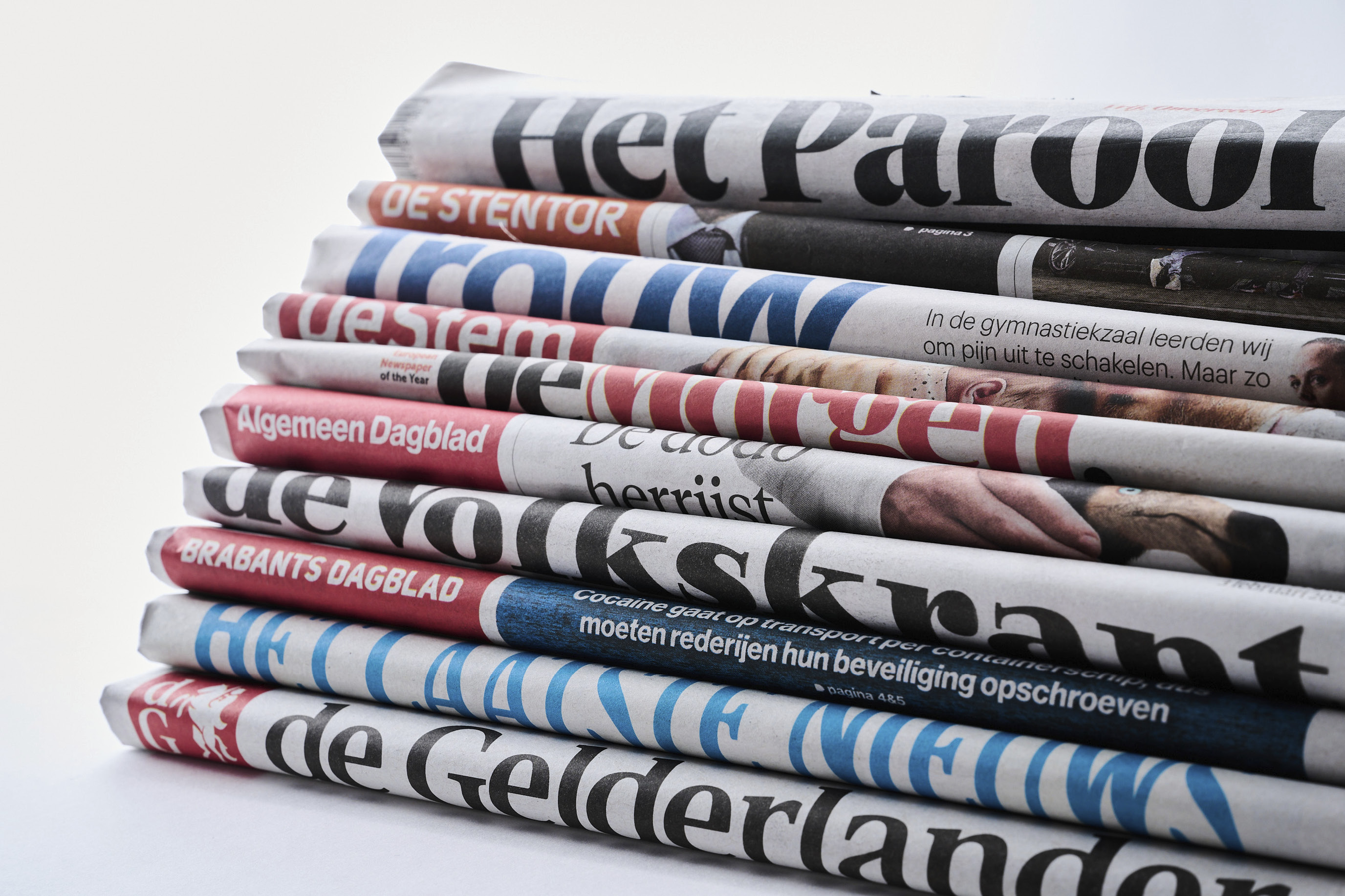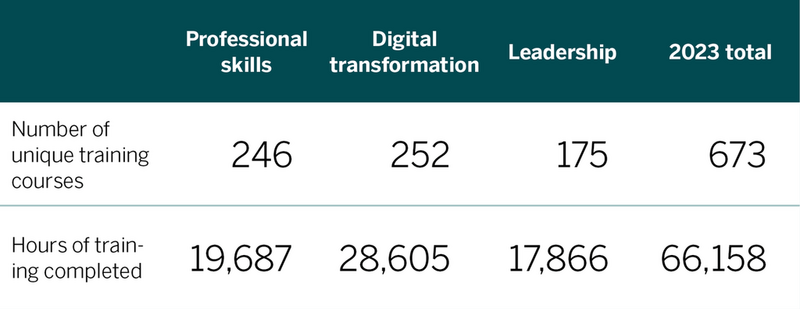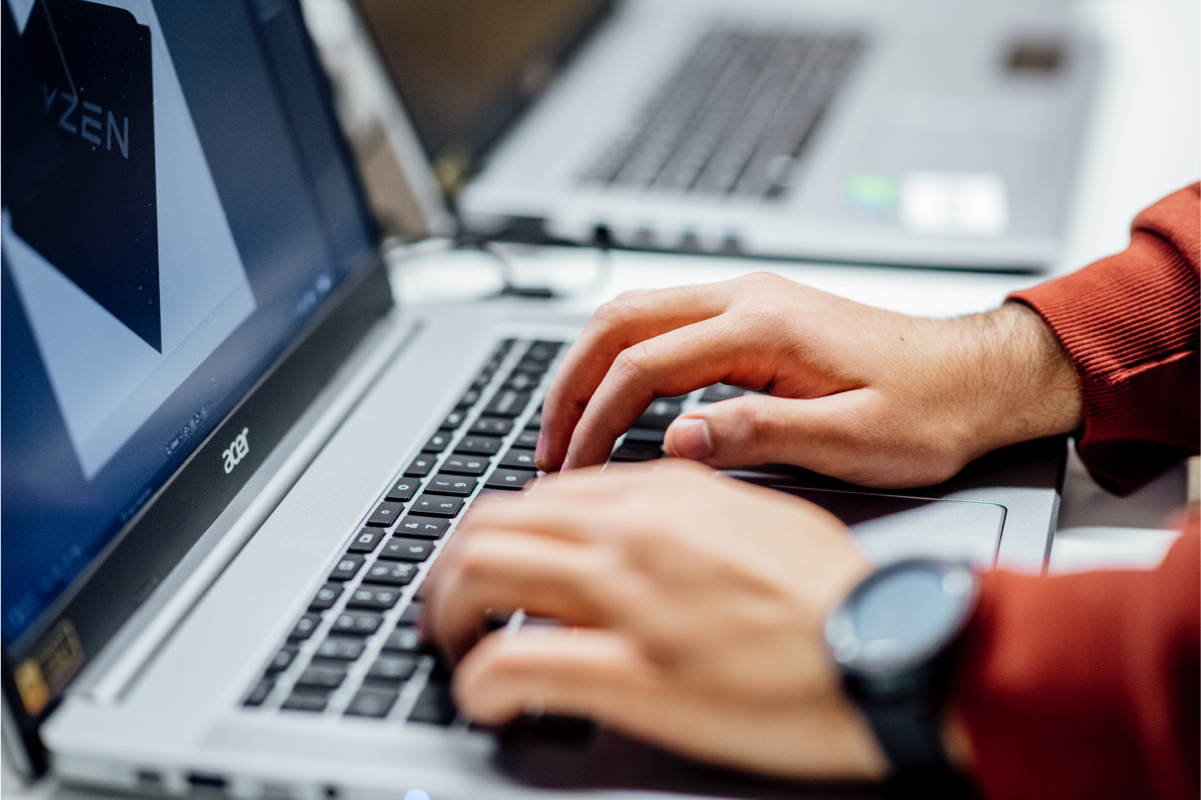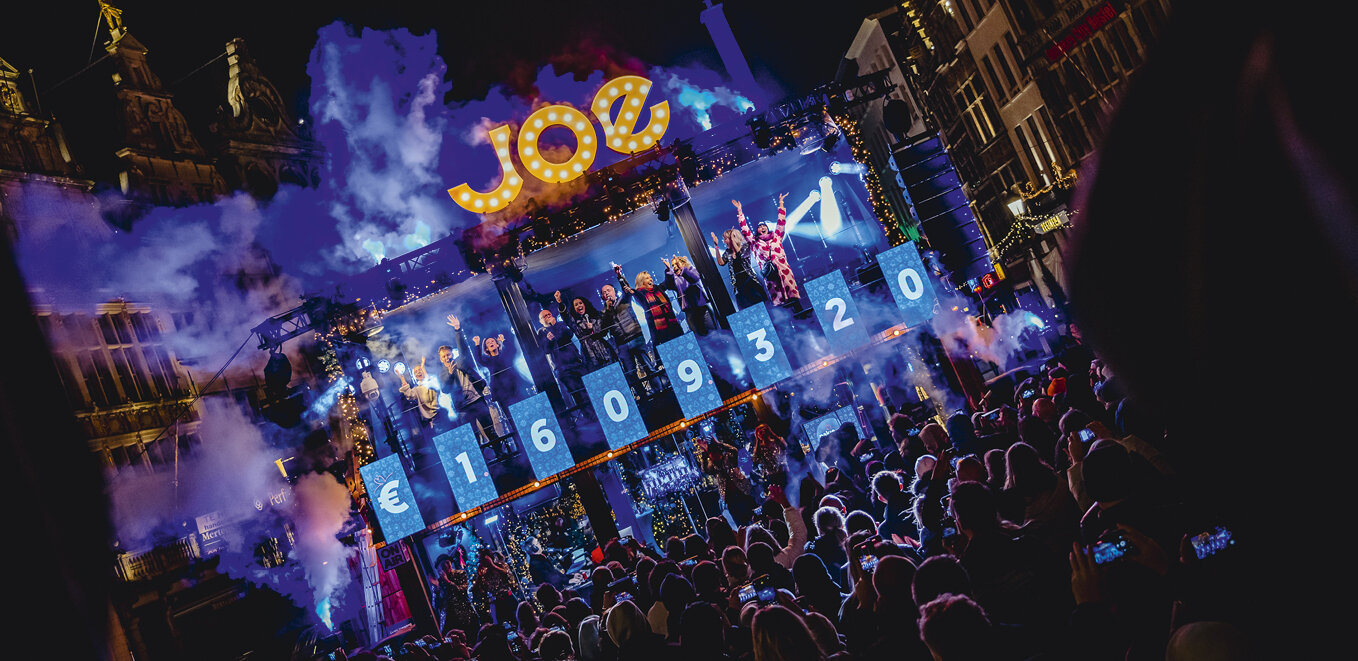ESG
Increasing positive impact,
Reducing negative effects
Every day, DPG Media reports on what’s going on in society and how it’s changing. Some brands have been doing this for hundreds of years. The way in which we create our media also impacts society and the environment.

Paul Vereijken
(36), ESG MANAGER AT DPG MEDIA
The six pillars of ESG policy (Environmental, Social and Governance) guide DPG media in increasing positive impact and reducing negative effects. This can only be achieved by working together, just like we do when we create our media.
Many people within DPG Media are passionate about implementing the aforementioned pillars. The next few pages outline the results of the efforts of dozens of our colleagues. This year, we’ll continue to build upon the firm foundation created in 2023. Working on societal impact is a permanent process. Reducing our ecological footprint will receive more attention than ever in 2024. The environmental impact of making media will be given more weight in the decisions to be made. It’s very fitting, therefore, that we’ll be moving into Mediavaert this year. It’s an office building that’s both green in terms of experience and because of its minimal impact on the surroundings. Let this set the tone for the rest of the year.
Pillar 1
Reducing our environmental footprint
Our contribution to reducing greenhouse gas emissions and handling the world around us responsibly.
Read more

Pillar 1
Reducing our environmental footprint
Our contribution to reducing greenhouse gas emissions and handling the world around us responsibly.
How do we measure our ecological footprint?
All activities by DPG Media and its employees emit greenhouse gases. The exact amount can be measured against the international standard in this area, the Greenhouse Gas Protocol (or GHG protocol for short). There are several greenhouse gases, but the protocol converts all of them to a single gas: carbon dioxide. This is why the term ‘CO₂ equivalent’ is used.
This method for keeping track of emissions has three main categories: scope 1, 2 and 3. Scope 1 comprises all emissions that are the direct result of using company buildings or cars. Examples of this would be burning natural gas for heating or petrol in a car. Scope 2 covers the emissions associated with all energy that is purchased, such as electricity. Scope 3 is the broadest category. It comprises the emissions of everything that is purchased, TV productions that are made, distribution of newspapers and magazines, energy use of the sites and apps, waste, travel (except using company cars) and working from home.
Every activity comes with CO₂e emissions, but every activity consists of all kinds of steps and materials. Newspapers and magazines consist of many kinds of paper and ink, and are distributed by thousands of trucks and cars. TV productions consist of set pieces, studios, on-site recordings and travels around the world. DPG Media’s CO₂e emissions are those associated with the products generated by more than a hundred brands. They are created by thousands of people and used by millions of people.
Mapping out the actual emissions is a complex and elaborate job. We’ll produce a more accurate map every year. At the moment, we have to rely in part on estimations based on averages and costs.
The CO₂e emissions given in this annual report are broken down in scopes 1, 2 and 3, and exclude the emissions associated with the construction of Mediavaert, those of companies that are partly owned by DPG Media and those caused by the consumer’s energy consumption. These will be added at a later stage.
What did we do in 2023 to reduce scopes 1 and 2?
- DPG Media Printing Amsterdam replaced one of the two large central heating boilers with an industrial heat pump. This allows us to use less gas. In 2023, the printing facility used 240,318 m3 of gas, versus 390,000 m3 to 560,000 m3 in previous years. In 2024, gas consumption will decrease further, as this is the first full year the heat pump is operational.
- New company cars and cars that have reached the end of their service lives are replaced by electric cars. The share of electric company cars increased to 27 percent of the entire fleet in 2023. At the end of 2024, we expect this to be around 40 percent. At the end of 2028, the fleet will be fully electric.
- We closed the data centre in Kobbegem. This data centre’s function was taken over by cloudhosting. This is efficient and more sustainable, because our cloudhosting provider uses sustainably generated electricity.
- The Hilversum office (Independer) was made more energy efficient. This will only have a tangible impact in 2024.
- We took stock of energy saving opportunities for the Vilvoorde location. This resulted in a plan involving the renovation of the boiler room, which we are executing in 2024.
- The three printing facilities drafted an energy saving plan. They are implementing the measures in 2024, which include new lighting machines, energy-efficient compressors and heat recovery
- The construction of Mediavaert, the new headquarters in the Netherlands. This building is set up in a very sustainable way: solar panels on the roof, heat and cold storage, gas-free and supplied with sustainably generated energy from the Netherlands once it opens its doors. Mediavaert is expected to be four to five times more energy efficient than the current offices in Amsterdam and Hoofddorp.
- Renewal of our electricity contracts: as of 2025, all electricity we purchase for printing facilities and office buildings in Belgium and the Netherlands will be certified wind energy from those countries. As a result, we expect to save 4,000 to 5,000 tonnes of CO₂e in 2025.
What did we do in 2023 to reduce scope 3?
- Optimisation of the magazine production chain: printing more magazines at the same time to save on logistics. The sizes have been slightly adjusted to save paper. The emissions associated with the production of Saturday supplements to newspapers and magazines decreased by 11 percent in 2023, as compared to the year before.
- The digital transformation of our newspaper and magazine titles brings down the total CO₂ emissions. We nonetheless aim to make the production of our newspapers and magazines even more environmentally friendly. Unfortunately, we didn’t manage this across the board in 2023. Economic circumstances and market developments forced us to procure newsprint from other suppliers. Even though paper use at our own printing facilities has decreased (by 4 percent), the CO₂ emissions associated with this paper have remained the same. In 2024, we’ll re-evaluate our partnerships with paper suppliers.
- In the Netherlands, we currently have more than 900 deliverers using electric bikes or other electric vehicles. That’s twice as many as the year before. We want to continue this growth in 2024, thereby progressively reducing deliveries by car at the end of the distribution chain. This way, more newspapers will be delivered sustainably.
- Our partner for newspaper distribution in Denmark, DAO, of which DPG Media is a minority shareholder, mainly uses electric bikes and scooters in and around cities. We are currently running a pilot to electrify delivery vans.
- In the Netherlands, we’ve switched to a differentiated mobility policy that encourages sustainable travel. At the moment, 30 percent of our employees uses public transport. Our ambition is for at least 50 percent of commutes and business travel to be done sustainably (public transport, electric car, bicycle) by 2030.
- With Scope3.com we’re working on mapping out and reducing the emissions associated with our digital advertising chain.
Reduction plan: the road to 2023
DPG Media will contribute to European climate agreements. This is why this year we’re working on a prediction of our greenhouse gas emissions until and including 2030. We’ll set a reduction target for each year. We’ll also start additional projects to reduce our emissions, both internally and together with our suppliers and other parties in the production chain. We’ll have our reduction approach validated by the Science Based Targets initiative (SBTi). This is an independent body that assesses companies’ sustainability plans and CO2e footprints against the climate agreements. It was set up by the United Nations, the World Resources Institute and the World Wildlife Fund. What’s more, DPG Media is pushing for standardisation of CO2e measurements and emission reductions in sector associations and initiatives such as the European Publishers Council, CommToZero, VIA Nederland and the Global Alliance for Responsible Media.
More sustainable packaging
Away with 33 million plastic packaging units
Working, travelling or producing differently: there are opportunities everywhere to decrease the impact on the environment. Major adjustments have been made to our magazines. “All of our magazines used to be sent to our subscribers in plastic covers. There has to be another way, we thought. And kids reading Tina and Donald Duck were also starting to ask for a change,” says Marieke Monden, Managing Director of Home Deco and Operations at the magazines.
Out of all magazines in the Netherlands and Belgium, 96 percent are now sent to subscribers plastic-free. “To this end, we print addresses on the back or wrap the magazine up in paper. This saves about 33 million plastic packaging units per year,” Monden says. The wish to use less plastic in packaging had been around a while, but the whole chain needed to be ready: from printing facilities and shipping partners to editing teams, marketing, sales and finance. This was the case two years ago. Monden: “Together with the Procurement Operations (printing supervision) department, we set the plastic-free shipping in motion. We started with a pilot for Tina and ZoZitDat. This went well, so we gradually added more magazines.”
This means that subscribers receive their magazines looking slightly different than before. Monden: “Some readers had to get used to it and early on we did receive some questions. But when readers reach out to us and we explain that our products are much more sustainable this way, they pretty much always respond with understanding.”
Are there more sustainability plans in the works? “We’re looking into the options of using more sustainable, recycled paper,” says Monden. “But also into limiting the digital storage space taken up by our visual materials and our archives, which would decrease CO2 emissions. Our commitment to finding new ways of working more sustainably is unwavering.”
Pillar 2
Strong and independent journalism
Investing in the continuous development of the profession and ensuring that our editing teams can spread news independently and free of constraints.
Read more

pillar 2
Strong and independent
journalism
Investing in the continuous development of the profession and ensuring that our editing teams can spread news independently and free of constraints.
Facts and figures
DPG Media has 20 news media in its portfolio.
The journalistic independence of those titles is safeguarded in a number of ways, including by 17 individual editorial statutes and 6 independent foundations.
In 2023, the Flemish and Dutch news media teams produced 1,400 unique articles per day.
These titles’ editing teams made use of the services of 1,934 journalists and many freelancers in 2023.
It requires innovative strength to stay relevant
Journalism is undergoing a major transfor-mation, which has only just begun. In this digital age, contents and appearance must constantly change to stay relevant for the audience at large. To this end, DPG Media and its editing teams build apps, sites, paywalls, newsletters, push messages and editorial systems.
But this transformation is also a challenge that presents journalism with a lot of opportunities. DPG Media provides help in bringing about the innovation every editing team is working on. An example of this would be De Campus, an internal training institute by and for journalists. In 2023, De Campus taught 152 unique training courses to 1,552 journalists affiliated to our media. These mainly revolved around digital transformation.
De Campus also organises webinars, presen-tations and workshops by experts from all over the world. There is a journalism handbook with manuals, which is continuously updated. And De Campus sends out a newsletter on journalistic innovation. The goal is to exchange knowledge and help editing teams by providing them with best practices from the media sector in their own countries and abroad.
Together with the editing team, journalistic data experts explore the best ways of translating insights on visitor behaviour into practical suggestions for journalists. How can they reach more people with their journalistic efforts and how can they tempt visitors into coming back? How can one give this new tool the right place, but not too dominant a place, in the journalistic process?
Time and resources have also been made available to help editing teams become more diverse and inclusive in their reports and footage selection. In 2023, DPG Media organised its second-ever traineeship geared towards enabling people from culturally diverse backgrounds to become journalists.
On Independent journalism, you will find a detailed explanation of how the independence of news media at DPG Media is safeguarded through such means as editorial statutes, independent foundations and editorial boards.
In the independent research into trust in news media by reuters and the university of oxford, our news media were rated as followed:

Pillar 3
Diverse and inclusive work environment
Keep investing in a safe environment where unique talent is acknowledged, recognised and involved.
Read more

Kennismaking Traineeship 2022: een rondleiding door de drukkerij.
Pillar 3
Diverse and inclusive work environment
Keep investing in a safe environment where unique talent is acknowledged, recognised and involved.
Journalistic talent traineeship
“I want to give people something to think about”
As a media company, we want to appeal to everyone in the Netherlands. Our editing teams should be a more accurate reflection of our country’s diversity, featuring younger and older people, people of colour and white people, people with and without a disability. As conventional methods have not yielded the desired results so far, we set up the journalistic talent traineeship in 2021. Hasna Elbaamrani completed this traineeship and is a journalist at NU.nl now. “Ever since becoming a journalist, I’ve experienced the marvellous impact I can have with my articles.”
Ten trainees spend five months receiving guidance from experienced mentors and training at De Volkskrant, Algemeen Dagblad, NU.nl and Margriet, amongst others. Elbaamrani: “During the pandemic, I started to think: am I still happy doing what I do? I had never seriously considered a career in journalism, simply because I hadn’t trained as a journalist. This was a unique opportunity to find out of I wanted to do this for a living.”
DPG Media’s aim for the traineeship is to make sure news is delivered from an even wider range of perspectives. Hasna says she wants to give people something to think about. “I used to do so as a programme maker, organising debates on societal themes, and now I’m doing it as a journalist. During the traineeship, fellow trainees and I got to do job shadowing in several editing teams. But NU.nl really made me feel at home right away. I immediately got the space and freedom to write about subjects I thought were important and didn’t receive enough attention.”
Facts And Figures
M/F ratio for total staff complement: 55%/45% (2023), 56%/44% (2022)
M/F ratio for senior management: 70%/30% (2023), 70%/30% (2022)
At DPG Media, the options for registering someone’s gender are: man, woman and non-binary. The above ratios are rounded off to whole percentages, which means non-binary isn’t expressed as a percentage.
Gender pay gap (women relative to men): Belgium -1.3%, Netherlands -1.2%, excluding Independer.
Social safety score: 8.2/10 (2023), 8.2/10 (2022)
Other Achievements
The difference in remuneration between men and women within DPG Media has been investigated, in accordance with European guidelines for such gender pay gap investigations. The pay gap may not exceed 5%. As of 2024, this will be investigated every year, with the addition of the brands in Denmark.
To work on the leadership of the future, a talent programme was launched in Belgium and the Netherlands in 2023. The group of participants consisted of 35 women and 22 men.
During a week themed around inclusivity in June, discussions were held with all employees about what it means to be a diverse and inclusive company and how everyone contributes to this.
Together with the production companies for TV and streaming platforms in Flanders, we’re working actively to create a more diverse cast in programmes.
Berlingske Media taught various workshops and training courses to prevent sexism on the work floor.
In Denmark, paternity leave is now comprised of the same number of weeks as maternity leave: 16.
Pillar 4
Development and growth of employees
Investing in (digital)knowledge and skills of our media creators, as they are our capital.
Read more

pillar 4
Development and growth of employees
Investing in (digital)knowledge and skills of our media creators, as they are our capital.
Personal Growth Within DPG Media
“Leaders don’t have all the answers”
For a media company to continue to be a market leader, the continuous development of its employees is essential. DPG Media ensures sufficient advancement opportunities and invests in talent, knowledge and skills, for example through the training institutes Academy by DPG Media and De Campus. Yann-Michaël De Hauwere told us about his personal growth path within DPG Media.
Having joined the organisation as a data scientist eight years ago, Yann-Michaël currently holds his fourth position within the company: B2C Data Strategy Manager. De Hauwere: “Over the years, data science has become a booming business and more and more attention is being paid to it within the organisation. The moment I saw an opportunity, I was always very vocal about it, which has been helpful. This enabled me to keep taking on more responsibilities and make great steps.”
He learnt a lot by taking internal training courses and figuring out things by himself. “Even managers aren’t omniscient. On the contrary, you need the knowledge of experts in your team,” says De Hauwere. There are many training opportunities within DPG Media, so everyone can choose in what direction they want to develop. From using AI in your work and writing a good interview to personal leadership: there are multiple options for every employee.
This is why De Hauwere gives his team a lot of autonomy. “I’m a huge advocate of freedom in our work, so employees can develop their problem-solving abilities.” But continued in-service training is also important. “It is exactly the combination of autonomy and knowledge that spark the greatest products and applications. I’m sure of this.”

Other achievements:
The academy gives the floor to top experts and managers within DPG Media so others can learn from the best.
De Campus developed a new training course on audience needs. More than 245 people completed this course so far.
Every two weeks, 3,500 employees receive a newsletter on journalistic innovation from De Campus.
Pillar 5
Responsible use of data
Collecting, storing and using personal and behavioural data transparently, carefully and fairly.
Read more

pillar 5
Responsible use of data
Collecting, storing and using personal and behavioural data transparently, carefully and fairly.
Facts and figures
- Reports of a potential data breach involving personal data 32
- Medium-risk data breach 2
- High-risk data breach 2
Medium-risk data breaches must be reported to the national personal data supervisory authorities. High-risk data breaches must also be reported to them and to the persons whose data was involved.
- Digital advertising revenue via the open market 12%
DPG Media wants to gradually reduce this percentage, partly because in the open market it’s less visible to us which data are being shared and with whom.
Other achievements
Our policy on dealing with personal data and other consumer data within DPG Media has been more firmly safeguarded in the organisation by tightening up procedures and identifying a group of internal experts responsible for monitoring them.
In 2023, generative Artificial Intelligence had its breakthrough. To ensure responsible use of this technology, we developed internal rules and educated colleagues on the matter.
Berlingske Media launched a self-service portal for consumers to inspect their personal data or have it deleted.
Being a good host on the web
“We take the user by the hand”
At DPG Media we have a common goal: dealing with data responsibly. “It’s all about being a good host,” says Director of DPG Network Dimitri Heikamp. “We wish to be transparent about how we handle data and explain this to our media users in a simple manner. That’s also what we’re doing right now, for instance by way of a self-developed privacy gate in the DPG Network.”
Some years ago, DPG Media was far too dependent on the conditions of big tech parties, which had access to all of the users’ data. Heikamp: “That felt unpleasant. We investigated building our own network incorporating all of our brands and platforms, which would offer a protected environment to use data responsibly. That’s how the DPG Network came about.”
In 2023, this network was equipped with its own privacy gate, which makes it possible to receive visitors even more personally and give them a clearer explanation of how DPG Media deals with data. “We did this because the standard European language about privacy is so complex, almost legal in nature, that users often don’t know what they’re actually giving permission for.”
This had to change, says Heikamp. “In our own privacy environments, where we of course comply with all European legislation, we really take the visitor by the hand. Using simple terms, we explain to you what we’re doing with your data. This makes things more understandable and manageable. In addition, we make sure you’re logged onto all of our titles after logging onto your DPG Media account once. It’s also becoming easier to customise your settings relating to privacy and data in a single place. Finally, we have an elaborate privacy portal, where we use a Q&A to explain what we’re doing with your data.”
The goal is to create a situation where a bond of trust with our end users goes hand in hand with our commercial objectives. Heikamp: “We’re transparent and honest about this. That’s the only way to build trust with one another.”

pillar 6
Social contribution
Giving young people a leg up by using the power of our media.
Facts and figures
With the Belgian brands VTM, Qmusic, HLN and bank/insurer Belfius, DPG Media supports the new youth movement JEZ!. Its first charity campaign in 2023 raised 3,219,191 euros for 200 youth organisations in Flanders and Brussels.
4,023 teachers registered on the Sidekick Sam Academy platform, an initiative originating from JEZ! Predecessor Red Nose Day and now supported by JEZ!. The platform provides Flemish teachers with knowledge and skills to support the mental wellbeing of their pupils.
With its Dutch brands, DPG Media supports actions that promote literacy across society. Together with the CPNB and the Children’s Book Week we’re increasing reading pleasure among children. We also made several magazine issues for people with low literacy levels. De Gelderlander provided free newspaper subscriptions to people with limited resources to increase their community involvement. We will expand this initiative on a national level.
DPG Media is a partner of Campus 19: a programme in which young people with fewer opportunities in society are retrained to be IT officers. DPG Media supports the programme in a variety of ways, for instance by making its building available for the training sessions. More than 100 young people started the training in 2023.
DPG Media offers lodging and technical support to 80 journalists from 3 independent Russian media outlets, enabling these journalists to continue to carry out their work independently and freely.
Pakje van je Hart
“Disadvantaged children feel seen”
In December 2023, Belgian radio station JOE raised 1.6 million euros through the Pakje van je Hart campaign. This meant 35,000 children from disadvantaged families received a present during the holiday season. “This initiative is a great match for the station’s warm character,” says Robin Vissenaekens, Channel Manager at JOE. “Our radio station served as a megaphone to raise awareness of poverty.”
It’s not a given for every child to receive a present during the holiday season. In Belgium, one in five young people grows up in poverty. Vissenaekens: “That’s a depressing figure. Many kids are putting together wish lists, whereas others can’t ask for any presents because there’s no money. When we at JOE asked the charitable organisation Kindergeluk to help us bring some joy to these children, they didn’t take a lot of convincing.”
JOE’s editing team received countless stories, making it apparent that anyone can end up in this situation. Vissenaekens: “The one that has stuck with me was a family with three children whose father got seriously ill and needed expensive surgery. Sadly enough, the father passed away and the family was left in severe debt, whereas they weren’t even living in poverty before. People often say: parents should just work a bit harder. But they’re already working as hard as they can! They sometimes literally skip meals so they can feed their children.”
JOE’s listeners helped make as many children happy as possible. There were three ways in which they could donate a symbolic present: via the online JOE Pakjesshop or the present truck that drove though the country, or at the JOE Christmas House on the Grote Markt square in Antwerp. Afterwards, the children received a gift voucher so they could choose a present themselves. Vissenaekens: “When kids say they finally feel seen, that’s the best present in the world. And the parents were very grateful: their children’s happy faces made them extremely happy.”